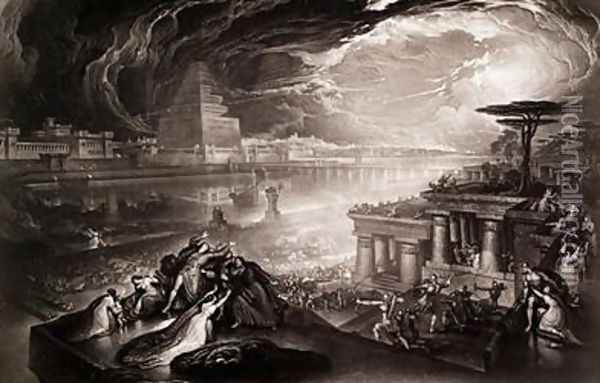John Martin’s The Fall of Babylon: A Study in Artistic Scale and Drama

John Martin’s painting “The Fall of Babylon” is a monumental example of how scale and dramatic effect can elevate a work of art to new heights of emotional impact. Completed in 1829, this painting exemplifies Martin’s mastery in depicting apocalyptic and historical themes through grandiose scale and theatrical compositions. This article explores how Martin uses these elements in “The Fall of Babylon” painting to enhance its emotional impact and how his approach compares to other works of his and his contemporaries.
The Power of Scale in The Fall of Babylon Painting
One of the most striking aspects of Martin’s “The Fall of Babylon” painting is its use of scale to convey the magnitude of the event. The painting’s expansive canvas, filled with towering structures and colossal figures, emphasizes the grandeur and devastation of the fall. Martin’s approach to scale is not just a matter of size but a deliberate choice to amplify the emotional response of the viewer.
In “The Fall of Babylon”, Martin utilizes a vast architectural backdrop, with the city’s walls and towers depicted in immense detail. This overwhelming scale creates a sense of grandeur and disaster, allowing the viewer to feel the enormity of the destruction. The sheer size of the painting and the monumental scale of its elements contribute to a feeling of awe and terror, aligning with the Romantic ideal of the sublime—where beauty and terror intersect.
Dramatic Effect and Emotional Impact
Martin’s use of dramatic effect is another key element in “The Fall of Babylon” painting. His use of chiaroscuro, or the contrast between light and shadow, heightens the painting’s emotional intensity. The intense, fiery light illuminating the cityscape contrasts starkly with the dark, shadowy areas, creating a dramatic tension that underscores the chaos and divine retribution depicted in the scene.
The composition of the painting further enhances its dramatic impact. Martin arranges the elements in a dynamic, almost theatrical manner, with flames and debris cascading through the composition, drawing the viewer’s eye towards the central catastrophe. The contrast between the towering, crumbling structures and the chaotic, infernal sky creates a powerful visual narrative that emphasizes the scale and severity of the fall.
Comparative Analysis: Martin’s Works and His Contemporaries
“The Fall of Babylon” painting is part of a broader body of work by Martin that employs similar techniques to evoke grandeur and drama. In his other notable works, such as The Great Day of His Wrath and The Last Judgment, Martin employs comparable methods of scale and dramatic composition. These paintings, like “The Fall of Babylon”, feature vast landscapes and overwhelming scenes of destruction, reinforcing the artist’s thematic focus on divine retribution and apocalyptic scenarios.
Martin’s approach to scale and drama can also be compared to his contemporaries. For instance, J.M.W. Turner, another prominent figure of the Romantic period, utilized scale and dramatic effects in his seascapes and historical paintings. Turner’s work, such as The Slave Ship, employs dramatic lighting and vast, turbulent compositions to evoke a powerful emotional response. While Turner’s focus is more on natural phenomena, the dramatic intensity and use of scale in his work share similarities with Martin’s approach in “The Fall of Babylon” painting.
Similarly, the works of Francisco Goya, particularly his Disasters of War series, offer a stark contrast to Martin’s grandiose style. Goya’s approach is more focused on the brutal realities of human conflict and suffering, utilizing scale and composition to convey a sense of immediacy and raw emotion. While Goya’s work is more grounded in the horrors of war, Martin’s paintings, including “The Fall of Babylon” painting, create a more theatrical and grandiose representation of catastrophic events.
The Impact of Scale and Drama on Art Appreciation
The use of scale and dramatic effect in “The Fall of Babylon” painting not only enhances its emotional impact but also invites viewers to engage with the painting on a deeper level. Martin’s ability to convey the magnitude of historical and biblical events through visual means allows the viewer to experience the grandeur and terror of the depicted scenes. The expansive scale and dramatic composition compel viewers to reflect on the themes of divine retribution, destruction, and the sublime.
Martin’s approach to scale and drama in “The Fall of Babylon” painting exemplifies the Romantic era’s fascination with the overwhelming and the sublime. His use of these elements serves to elevate the emotional and thematic depth of the painting, aligning with the broader artistic goals of his time. By comparing Martin’s techniques with those of his contemporaries, it becomes clear that his focus on monumental scale and dramatic intensity was a defining characteristic of his artistic vision.
Conclusion
John Martin’s “The Fall of Babylon” painting stands as a testament to the power of artistic scale and dramatic effect in evoking emotional responses. Martin’s mastery of these techniques enhances the painting’s impact, allowing it to resonate with viewers through its grandiose portrayal of historical and biblical themes. By examining Martin’s work in the context of his oeuvre and comparing it to his contemporaries, we gain a deeper appreciation for how scale and drama can transform a painting into a powerful emotional experience.



